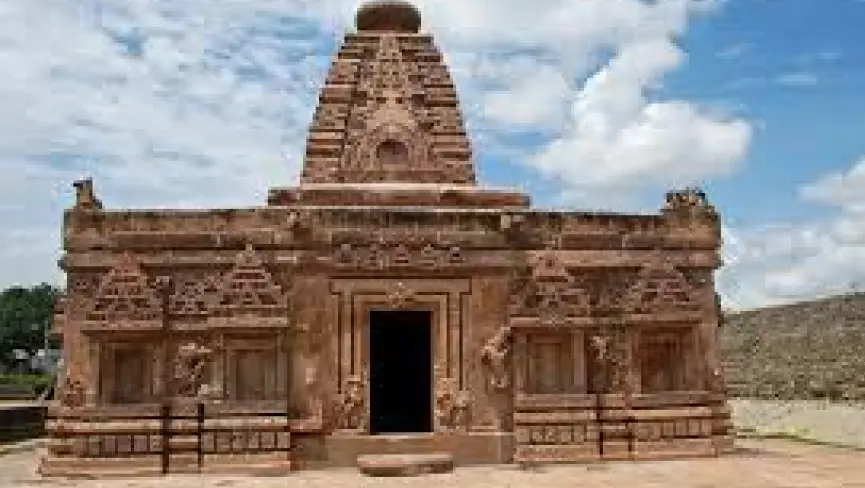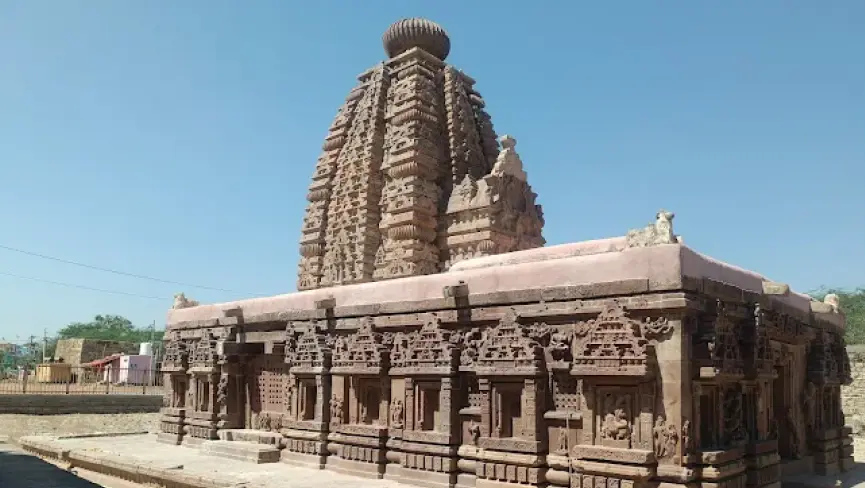
Nava Brahma Temples of Alampur – History, Architecture & Significance
The Nava Brahma Temples of Alampur are a remarkable group of nine ancient temples dedicated to Lord Shiva, located on the banks of the Tungabhadra River in Telangana. Built during the 7th–9th century by the Badami Chalukyas, these temples are celebrated for their unique blend of Nagara and Dravidian architectural styles. Each temple, with its distinct design and spiritual essence, reflects the artistic brilliance and cultural depth of early South Indian temple architecture. Closely associated with the nearby Jogulamba Temple, one of the 18 Shakti Peethas, the Nava Brahma Temples form a sacred destination that attracts devotees, historians, and travelers alike.
History of Nava Brahma Temples
The Nava Brahma Temples of Alampur were built during the reign of the Badami Chalukyas between the 7th and 9th centuries CE. The Chalukyas were great patrons of art, culture, and architecture, and Alampur was one of their important religious and cultural centers. These temples reflect the early phase of Chalukyan temple architecture, which later evolved into the grand styles seen in Pattadakal and Aihole.
The word “Nava Brahma” refers to the nine distinct temples dedicated to Lord Shiva, each representing a different manifestation of the divine. These temples not only served as centers of Shaiva worship but also symbolized the Chalukyas’ devotion and architectural vision.
Over centuries, the temples witnessed the rule of different dynasties, including the Kakatiyas, Vijayanagara kings, and Qutb Shahi rulers. Despite invasions and natural calamities, most of the temples survived, though some underwent damage and restoration. The Bala Brahma Temple remains active even today, continuing the centuries-old tradition of daily worship.
The Nava Brahma Temples also hold a special place in mythology as they are closely connected to the Jogulamba Temple, one of the 18 Shakti Peethas. Together, they represent the sacred union of Shiva and Shakti, making Alampur a highly revered pilgrimage site in South India.
Architecture of Nava Brahma Temples
The Nava Brahma Temples of Alampur are an outstanding example of early Chalukyan architecture, showcasing a blend of North Indian Nagara style and South Indian Dravidian features. Built with red sandstone, these temples reflect both artistic creativity and spiritual symbolism, making them a treasure for historians and devotees alike.
Key Architectural Features
-
Nagara Style Shikharas (Towers): Unlike the typical Dravidian gopurams of South India, the Nava Brahma Temples feature curvilinear towers (shikharas) resembling the Nagara style of North India.
-
Garbhagriha (Sanctum Sanctorum): Each temple enshrines a Shiva Lingam, representing a distinct form of Lord Shiva.
-
Mandapas (Halls): The temples have pillared halls with beautifully carved columns showcasing mythological stories, deities, and floral patterns.
-
Sculptural Art: Exquisite carvings of Ganesha, Vishnu, Durga, and celestial beings decorate the walls, reflecting the Chalukyan mastery in stone craft.
-
Material Used: Constructed with sandstone, the temples have endured centuries of weather and invasions, standing as a testament to engineering excellence.
Unique Aspect of Each Temple
While all nine temples share common architectural elements, each has its distinctive design and carvings. For example:
-
Swarga Brahma Temple is noted for its elegant carvings.
-
Padma Brahma Temple has a lotus-themed sanctum.
-
Bala Brahma Temple is the main shrine where daily rituals are still performed.
List of the Nava Brahma Temples
The Nava Brahma Temples of Alampur are a group of nine ancient shrines dedicated to Lord Shiva, each with its own unique architectural style and spiritual essence. Here is the complete list:
-
Swarga Brahma Temple – Famous for its fine carvings and elegant design, this temple reflects the artistic excellence of the Chalukyan era.
-
Padma Brahma Temple – Known for its lotus-themed sanctum and intricate sculptures.
-
Arka Brahma Temple – Dedicated to the Sun aspect of Lord Shiva, with carvings representing solar symbolism.
-
Kumara Brahma Temple – A smaller temple believed to be connected with Lord Kumara (Kartikeya), the son of Shiva.
-
Vira Brahma Temple – Distinctive for its bold carvings and warrior-like symbolic representations.
-
Garuda Brahma Temple – Features carvings inspired by Garuda, the divine vehicle of Lord Vishnu, showing Shaiva-Vaishnava harmony.
-
Vishva Brahma Temple – A beautifully ornamented temple with carvings depicting universal cosmic themes.
-
Taraka Brahma Temple – Associated with liberation (taraka), symbolizing Shiva as the savior of devotees.
-
Bala Brahma Temple – The main and most significant temple, still an active place of worship where rituals and festivals are performed regularly.
These nine temples together represent the nine forms of Lord Shiva and are considered highly sacred. Their spiritual and architectural significance makes Alampur one of the most important Shaiva Kshetras in South India.
Religious & Spiritual Significance of Nava Brahma Temples
The Nava Brahma Temples of Alampur hold immense religious and spiritual importance, not only in Telangana but across India. Dedicated to Lord Shiva in nine different forms, these temples symbolize the deep-rooted traditions of Shaivism and the spiritual vision of the Badami Chalukyas.
Connection with Jogulamba Shakti Peetha
One of the most significant aspects of Alampur is its association with the Jogulamba Temple, which is recognized as one of the 18 Maha Shakti Peethas in India. Together, the Jogulamba Temple (Shakti) and the Nava Brahma Temples (Shiva) represent the sacred union of Shiva and Shakti, making Alampur a highly revered pilgrimage destination.
Continuity of Worship
-
The Bala Brahma Temple remains an active place of worship, where daily rituals, special pujas, and annual festivals like Maha Shivaratri are celebrated with grandeur.
-
Despite being centuries old, the temples still attract thousands of pilgrims, showcasing the unbroken tradition of devotion to Lord Shiva.
Mythological Importance
-
According to legends, worshipping at the Nava Brahma Temples grants spiritual liberation (moksha) and divine blessings.
-
Each temple represents a different form of Shiva, offering devotees unique spiritual experiences.
Cultural & Pilgrimage Value
-
The Nava Brahma Temples are considered one of the Pancharama Kshetras’ extended spiritual circuits, making them an essential stop for Shaiva devotees.
-
They serve as a center for both pilgrimage and heritage tourism, drawing devotees, historians, and culture seekers alike.
In essence, the Nava Brahma Temples are not only architectural marvels but also a living symbol of faith, divinity, and spiritual continuity.
Why Visit the Nava Brahma Temples of Alampur?
A visit to the Nava Brahma Temples of Alampur is more than just a historical exploration—it is a journey into spirituality, heritage, and timeless art. These temples stand as living monuments of devotion, architecture, and cultural brilliance. Here’s why every traveler and devotee should plan a trip to Alampur:
1. Experience Ancient Chalukyan Architecture
Built between the 7th–9th centuries, the temples showcase a rare combination of Nagara and Dravidian styles, making them a visual delight for history lovers and architecture enthusiasts.
2. Connect with Spiritual Energy
Dedicated to nine forms of Lord Shiva, the temples radiate divine vibrations. The Bala Brahma Temple is still active, allowing visitors to participate in daily rituals and festivals like Maha Shivaratri.
3. Discover the Sacred Union of Shiva & Shakti
Located alongside the Jogulamba Temple, one of the 18 Shakti Peethas, Alampur offers a unique spiritual experience where Shaivism and Shaktism come together in harmony.
4. A Peaceful Pilgrimage by the Tungabhadra River
Situated on the banks of the sacred Tungabhadra River, the temple complex provides a serene and meditative environment, perfect for seekers of peace and inner reflection.
5. A Heritage Destination for All
Whether you are a devotee, history enthusiast, student of architecture, or a traveler seeking offbeat destinations, Alampur offers a blend of spirituality and heritage that appeals to everyone.
In short, visiting the Nava Brahma Temples is an opportunity to step back in time, immerse in divine energy, and witness the artistic legacy of India’s glorious past.


